Module1 Getting to know you Unit2 My way to school period 1 -period 2 表格式教案
文档属性
| 名称 | Module1 Getting to know you Unit2 My way to school period 1 -period 2 表格式教案 | 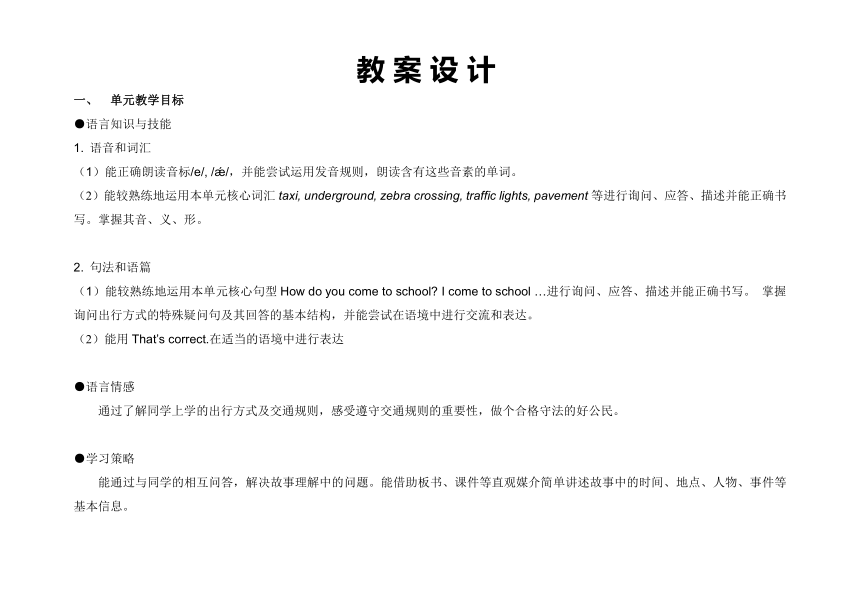 | |
| 格式 | docx | ||
| 文件大小 | 163.8KB | ||
| 资源类型 | 教案 | ||
| 版本资源 | 牛津上海版(试用本) | ||
| 科目 | 英语 | ||
| 更新时间 | 2023-09-25 12:43:40 | ||
图片预览

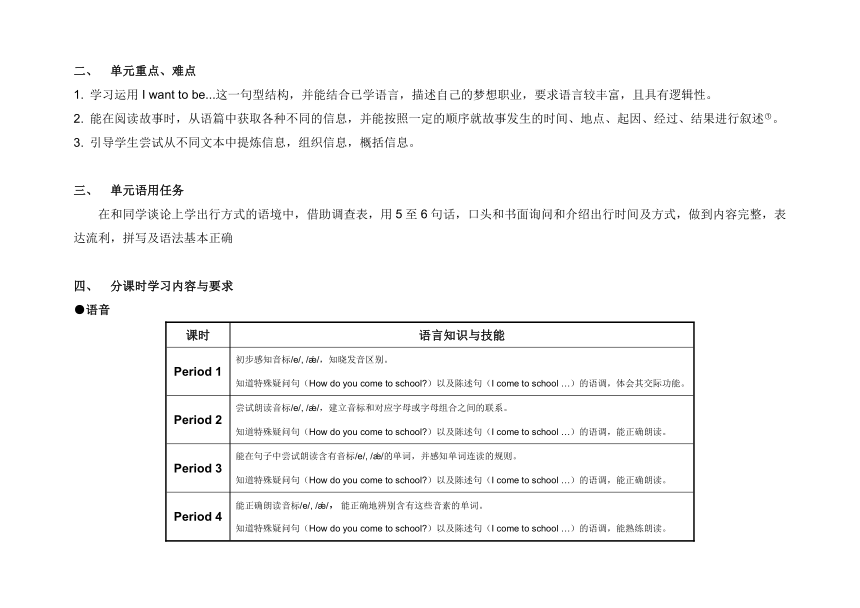
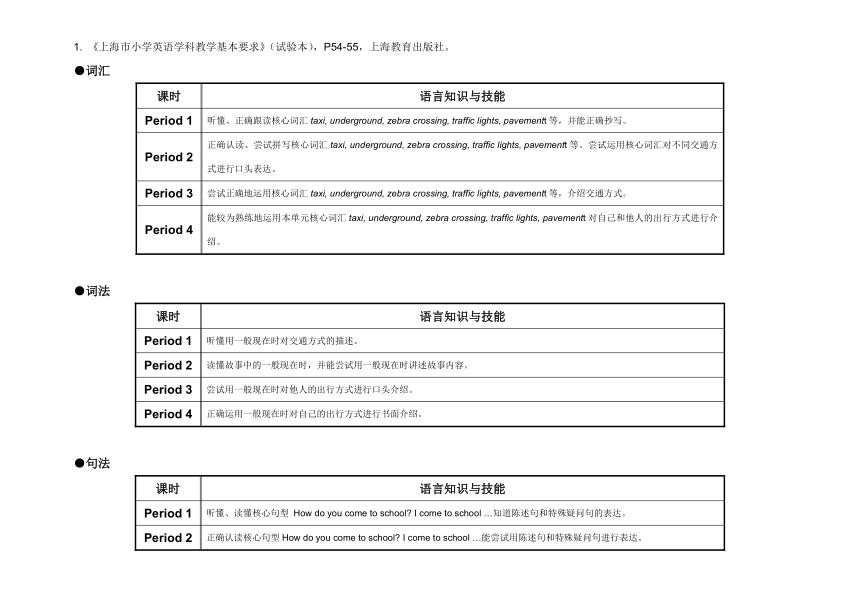
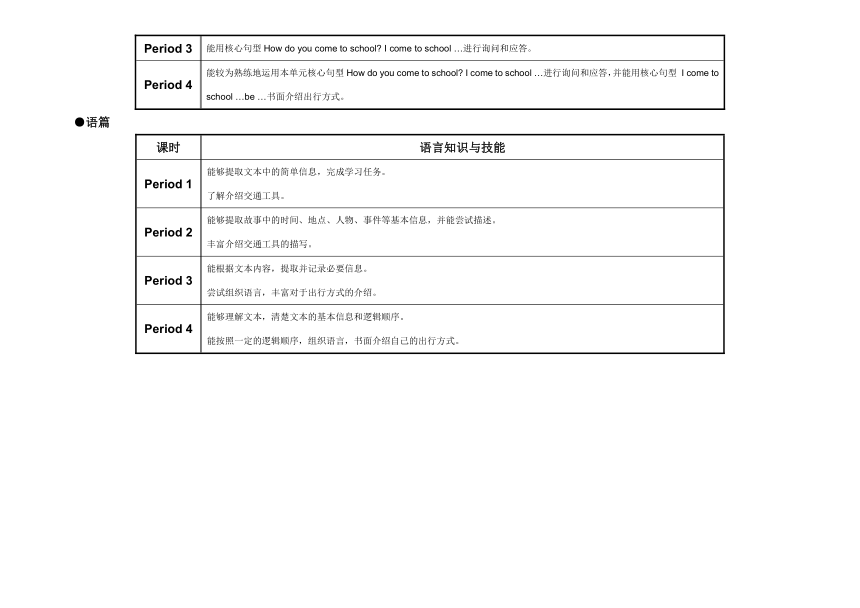
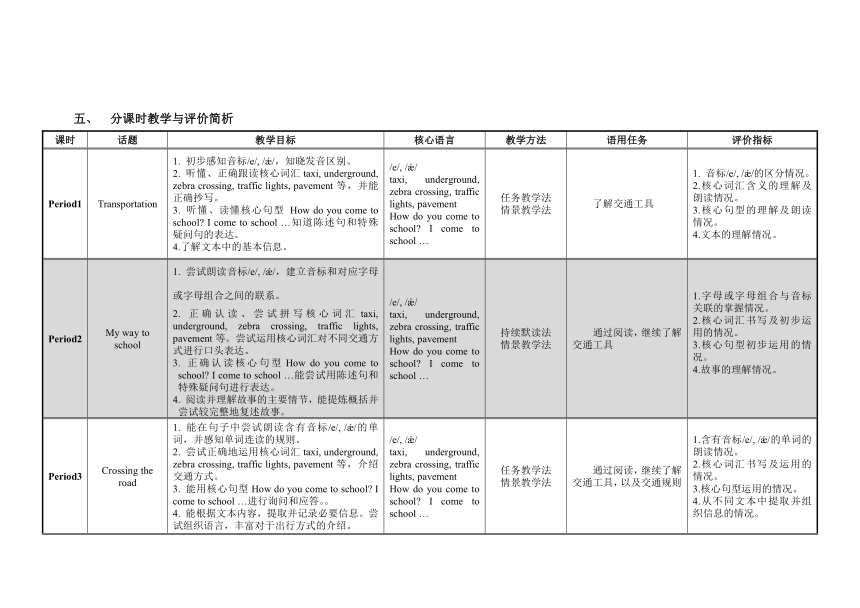
文档简介
教案设计
单元教学目标
●语言知识与技能
1. 语音和词汇
(1)能正确朗读音标/e/, / /,并能尝试运用发音规则,朗读含有这些音素的单词。
(2)能较熟练地运用本单元核心词汇taxi, underground, zebra crossing, traffic lights, pavement等进行询问、应答、描述并能正确书写。掌握其音、义、形。
2. 句法和语篇
(1)能较熟练地运用本单元核心句型How do you come to school I come to school …进行询问、应答、描述并能正确书写。 掌握询问出行方式的特殊疑问句及其回答的基本结构,并能尝试在语境中进行交流和表达。
(2)能用That’s correct.在适当的语境中进行表达
●语言情感
通过了解同学上学的出行方式及交通规则,感受遵守交通规则的重要性,做个合格守法的好公民。
●学习策略
能通过与同学的相互问答,解决故事理解中的问题。能借助板书、课件等直观媒介简单讲述故事中的时间、地点、人物、事件等基本信息。
单元重点、难点
1. 学习运用I want to be...这一句型结构,并能结合已学语言,描述自己的梦想职业,要求语言较丰富,且具有逻辑性。
2. 能在阅读故事时,从语篇中获取各种不同的信息,并能按照一定的顺序就故事发生的时间、地点、起因、经过、结果进行叙述。
3. 引导学生尝试从不同文本中提炼信息,组织信息,概括信息。
单元语用任务
在和同学谈论上学出行方式的语境中,借助调查表,用5至6句话,口头和书面询问和介绍出行时间及方式,做到内容完整,表达流利,拼写及语法基本正确
分课时学习内容与要求
●语音
课时 语言知识与技能
Period 1 初步感知音标/e/, / /,知晓发音区别。 知道特殊疑问句(How do you come to school )以及陈述句(I come to school …)的语调,体会其交际功能。
Period 2 尝试朗读音标/e/, / /,建立音标和对应字母或字母组合之间的联系。 知道特殊疑问句(How do you come to school )以及陈述句(I come to school …)的语调,能正确朗读。
Period 3 能在句子中尝试朗读含有音标/e/, / /的单词,并感知单词连读的规则。 知道特殊疑问句(How do you come to school )以及陈述句(I come to school …)的语调,能正确朗读。
Period 4 能正确朗读音标/e/, / /,能正确地辨别含有这些音素的单词。 知道特殊疑问句(How do you come to school )以及陈述句(I come to school …)的语调,能熟练朗读。
1. 《上海市小学英语学科教学基本要求》(试验本),P54-55,上海教育出版社。
●词汇
课时 语言知识与技能
Period 1 听懂、正确跟读核心词汇taxi, underground, zebra crossing, traffic lights, pavementt等,并能正确抄写。
Period 2 正确认读、尝试拼写核心词汇taxi, underground, zebra crossing, traffic lights, pavementt等。尝试运用核心词汇对不同交通方式进行口头表达。
Period 3 尝试正确地运用核心词汇taxi, underground, zebra crossing, traffic lights, pavementt等,介绍交通方式。
Period 4 能较为熟练地运用本单元核心词汇taxi, underground, zebra crossing, traffic lights, pavementt对自己和他人的出行方式进行介绍。
●词法
课时 语言知识与技能
Period 1 听懂用一般现在时对交通方式的描述。
Period 2 读懂故事中的一般现在时,并能尝试用一般现在时讲述故事内容。
Period 3 尝试用一般现在时对他人的出行方式进行口头介绍。
Period 4 正确运用一般现在时对自己的出行方式进行书面介绍。
●句法
课时 语言知识与技能
Period 1 听懂、读懂核心句型 How do you come to school I come to school …知道陈述句和特殊疑问句的表达。
Period 2 正确认读核心句型How do you come to school I come to school …能尝试用陈述句和特殊疑问句进行表达。
Period 3 能用核心句型How do you come to school I come to school …进行询问和应答。
Period 4 能较为熟练地运用本单元核心句型How do you come to school I come to school …进行询问和应答,并能用核心句型 I come to school …be …书面介绍出行方式。
●语篇
课时 语言知识与技能
Period 1 能够提取文本中的简单信息,完成学习任务。 了解介绍交通工具。
Period 2 能够提取故事中的时间、地点、人物、事件等基本信息,并能尝试描述。 丰富介绍交通工具的描写。
Period 3 能根据文本内容,提取并记录必要信息。 尝试组织语言,丰富对于出行方式的介绍。
Period 4 能够理解文本,清楚文本的基本信息和逻辑顺序。 能按照一定的逻辑顺序,组织语言,书面介绍自己的出行方式。
分课时教学与评价简析
课时 话题 教学目标 核心语言 教学方法 语用任务 评价指标
Period1 Transportation 1. 初步感知音标/e/, / /,知晓发音区别。 2. 听懂、正确跟读核心词汇taxi, underground, zebra crossing, traffic lights, pavement等,并能正确抄写。 3. 听懂、读懂核心句型 How do you come to school I come to school …知道陈述句和特殊疑问句的表达。 4.了解文本中的基本信息。 /e/, / / taxi, underground, zebra crossing, traffic lights, pavement How do you come to school I come to school … 任务教学法 情景教学法 了解交通工具 1. 音标/e/, / /的区分情况。 2.核心词汇含义的理解及朗读情况。 3.核心句型的理解及朗读情况。 4.文本的理解情况。
Period2 My way to school 1. 尝试朗读音标/e/, / /,建立音标和对应字母或字母组合之间的联系。 2. 正确认读、尝试拼写核心词汇taxi, underground, zebra crossing, traffic lights, pavement等。尝试运用核心词汇对不同交通方式进行口头表达。 3. 正确认读核心句型How do you come to school I come to school …能尝试用陈述句和特殊疑问句进行表达。 4. 阅读并理解故事的主要情节,能提炼概括并尝试较完整地复述故事。 /e/, / / taxi, underground, zebra crossing, traffic lights, pavement How do you come to school I come to school … 持续默读法 情景教学法 通过阅读,继续了解交通工具 1.字母或字母组合与音标关联的掌握情况。 2.核心词汇书写及初步运用的情况。 3.核心句型初步运用的情况。 4.故事的理解情况。
Period3 Crossing the road 1. 能在句子中尝试朗读含有音标/e/, / /的单词,并感知单词连读的规则。 2. 尝试正确地运用核心词汇taxi, underground, zebra crossing, traffic lights, pavement等,介绍交通方式。 3. 能用核心句型How do you come to school I come to school …进行询问和应答。。 4. 能根据文本内容,提取并记录必要信息。尝试组织语言,丰富对于出行方式的介绍。 /e/, / / taxi, underground, zebra crossing, traffic lights, pavement How do you come to school I come to school … 任务教学法 情景教学法 通过阅读,继续了解交通工具,以及交通规则 1.含有音标/e/, / /的单词的朗读情况。 2.核心词汇书写及运用的情况。 3.核心句型运用的情况。 4.从不同文本中提取并组织信息的情况。
Period4 Mr Black’s journey to work 1. 能正确朗读音标/e/, / /,能正确地辨别含有这些音素的单词。 2. 能较为熟练地运用本单元核心词汇taxi, underground, zebra crossing, traffic lights, pavement对自己和他人的出行方式进行介绍。 3. 能较为熟练地运用本单元核心句型How do you come to school I come to school …进行询问和应答,并能用核心句型 I come to school …be …书面介绍出行方式。 4. 能够理解文本,清楚文本的基本信息和逻辑顺序。能按照一定的逻辑顺序,组织语言,书面介绍自己的出行方式。 /e/, / / taxi, underground, zebra crossing, traffic lights, pavement How do you come to school I come to school … 任务教学法 情景教学法 在和同学谈论上学出行方式的语境中,借助调查表,用5至6句话,口头和书面询问和介绍出行时间及方式,做到内容完整,表达流利,拼写及语法基本正确 1.含有音标/e/, / /的单词的辨别情况。 2.核心词汇书写及运用的情况。 3.核心句型运用的情况。 4.运用核心语言有逻辑地书面介绍自己的出行方式。
分课时教学文本及作业
第一课时文本
Jill:How do you come to school, Alice
Alice: I come to school on foot. I live near school.
Jill: When do you leave home
Alice: I leave home at a quarter to eight.
Jill: How do you come to school, Kitty
Kitty: I come to school on foot too. Alice and I always walk to school together.
Jill: How about you, Peter
Peter: I don’t live near school. I come to school by bus. I leave home at about sever thirty.
Jill: When do you arrive at school
Peter: At about eight o’clock.
回家作业及评价
1. Listening: Listen to the tape of P7-8
2. Reading: Read after the tape of P7-8
3. Writing: Copy the words: taxi, underground
Workbook page 11
第二课时文本
Jill:How do you come to school, Alice
Alice: I come to school on foot. I live near school.
Jill: When do you leave home
Alice: I leave home at a quarter to eight.
Jill: How do you come to school, Kitty
Kitty: I come to school on foot too. Alice and I always walk to school together.
Jill: How about you, Peter
Peter: I don’t live near school. I come to school by bus. I leave home at about sever thirty.
Jill: When do you arrive at school
Peter: At about eight o’clock.
回家作业及评价
1. Listening: Listen to the tape of P8 --- Look and say
2. Reading: Read after the tape of P8 --- Look and say
3. Writing: Workbook page 12
Write a report according to the table on SB P11
第三课时文本
Miss Zhang: Look at this poster. Where do you cross the road
Peter: We cross the road at traffic lights or at zebra crossings.
Miss Zhang: That’s right. How do you cross the road
Danny: We wait on the pavement for the green light.
Alice: We look left first, then look right, and then cross the road.
Miss Zhang: That’s correct. Walk quickly, but don’t run on the road.
回家作业及评价
1. Listening: Listen to the tape of P9
2. Reading: Read after the tape of P9
3. Writing: Copy the word and phrases: pavement, traffic lights, zebra crossing
Workbook P8--P10
第四课时文本
Mr Black is a new teacher at Rainbow Primary School. He lives on Green Road. It’s far away from his school. This is Mr Black’s journey to work.
First, Mr Black walks from home to the underground station. Next, Mr Black takes Line 2. He gets on the train at Green Road Station. He stays on the train for about 12 minutes and gets off at Park Street Station. Then, Mr Black takes Bus No. 12. He gets on the bus at Dragon Street Stop. He stays on the bus for about fifteen minutes and gets off at Rainbow Road Bus Stop. Finally, Mr Black walks from the bus stop to Rainbow Primary School for about 10 minutes.
What a long journey!
回家作业及评价
1、Read: Mr Black’s journey to work
2、Retell: Mr Black’s journey home
单课教学流程
Period 1
PROCEDURES CONTENTS METHODS PURPOSES
Ⅰ. Pre-task Preparation
Warming-up Daily talk: 1 How many months are there in a year What are they 2 What’s the fifth month of a year 3 Is Monday the first day of a week 4 What day is today 5 What’s the date today 6 When is your birthday 7 Is your home near your school 8 Do you walk to school every day Ask and answer in pairs and try to find the answers. 通过问答热身,帮助学生进入学习的最佳状态。
Ⅱ. While-task Procedure
Content1: I always ride my bike to school. I always come to school by bike.
1.Elicitation 1.Listen and enjoy on SB p7 2. The introduction of Ben. Ben: Hi, I’m Ben. I’m fourteen years old. I’m a student of Rainbow Middle School. I live on Garden Street. But my school is on Rainbow Road. It’s far away from my home. So I never walk to school. I always ride my bike to school. 1. Look at the video and enjoy the rhyme. 2. Listen and learn the new sentences. 通过Ben的自我介绍,帮助学生回忆旧知,同时引出今天的新授内容。
2. Mechanical Practice 1. The sentences: I always ride my bike to school. I always come to school by bike. 1. Have the Ps to listen and repeat. 2. To learn the different expresses of the one meaning. 通过比较让学生了解同一意思的两种不同表达。
Content2: taxi, underground, How do you come to school
1.Elicitation Make the short dialogue. Ben: I come to school by bike. How do you come to school Peter: I come to school by … Danny: I come to school by … 1 Try to find the answers. 用问答引出新授单词, 将单词教学放入句型中。
2. Mechanical Practice taxi, underground, How do you come to school 1. Try to repeat the new words for several times. 2. Try to read the sentences for several times. 3. Try to answer the question. 通过反复朗读在掌握单词的读音的同时也掌握了句型的用法。
3. Meaningful practice Questions: 1.How does … come to school 2 The difference between: How do you come to school How do you go to school 1. Try to find the answers and pay attention the differences between the verbs. 2 Read the sentences. 1 To learn the meanings of the sentences. 2 To learn the answers of the sentences. 通过比较区分两种句型的不同,提醒学生注意句意的不同与回答的不同。
Ⅲ. Post-task Activity
Activity1 Look and write Look at the pictures and fill in the blanks according to the examples. 通过练习巩固所学新知。
Activity2 Look and write 1. Try to read the passage. 帮助学生将前后知识融会贯通,同时提升学生的朗读能力。
Board design: taxi underground How do you come to school I come to school …
Period 2
PROCEDURES CONTENTS METHODS PURPOSES
Ⅰ. Pre-task Preparation
Warming-up Listen and enjoy Ben rides his bike to school. Ben always rides. He never walks. He always rides. Ben always rides. Kitty always walks to school. Kitty never rides. She is only ten years old. So she never rides. Read the Rhyme together. 通过朗读儿歌来调节课堂学习的气氛,帮助学生更好的学习英语。
Revision Ask and answer: 1 How does Ben come to school 2 Does Kitty come to school by bike Why 3 How does Kitty come to school 4 How do you come to school Try to answer these questions. 通过回答问题,帮助学生回顾上节课所学内容。
Ⅱ. While-task Procedure
Content1: leave home, arrive at
1.Elicitation Look and answer To watch the video and try to answer the questions. 通过看录像回答问题,帮助学生提升从对话中提取关键信息的能力。
2. Mechanical Practice leave home arrive at 1 To read the phrases. 2 To learn the meaning of the phrases.
3. Meaningful practice Look and say Watch the dialogue again. Act the dialogue in pairs. 通过调查访问,采集身边的信息,巩固问答句。
Ⅲ. Post-task Activity
Activity 1 Ask and answer: Q1: How do you come to school Q2: When do you leave home Q3: When do you arrive at school Ask and answer between Ps and Te
Activity 2 Do a survey 1 Give Ps the example 2 Ask and answer in pairs and try to fill in the table on SB p11 为了兼顾到每一位学生,所以先给出例子,让学生高效的完成表格。
Activity3 Try to say 1 Give Ps the example 2 Try to say their own friends. 活学活用。
Homework 1. Listening: Listen to the tape of P8 --- Look and say 2. Reading: Read after the tape of P8 --- Look and say 3. Writing: Workbook page 12 Write a report according to the table on SB P11
Board design: zebra crossing traffic lights pavement How do you come to school I come to school …
Period 3
PROCEDURES CONTENTS METHODS PURPOSES
Ⅰ. Pre-task Preparation
Warming-up Listen and enjoy Read the Rhyme together.
Ⅱ. While-task Procedure
Content1: traffic light, zebra crossing, pavement A dialogue: Where do we cross the road How do we cross the road
1.Elicitation Media SB: P9 Say and act Look and answer 通过看动画,回答问题,理解对话內容。
2. Mechanical Practice Ask and answer The chant: Cross the road, cross the road. At traffic lights or at zebra crossings. Cross the road, cross the road. Wait on the pavement and wait for the green light. Cross the road, cross the road. Look left then look right. Cross the road, cross the road. Walk very quickly but do not run. 1. Show the steps of crossing the road one by one. 2. Read the key words for several times 3. Read the chant 将对话内容串联成chant,帮助学生记忆所学内容,同时教会学生要注意交通安全,将两纲内容无痕渗透。
Ⅲ. Post-task Activity
Activity 1 Say and act Act out the dialogue 通过对话表演检验学生本节课所学情况。
Activity2 Do a survey How do your classmates come to school 1. Read the short passages. 2. Answer the questions. 3. Report 通过找寻答案,让学生更好的对句型进行理解,加深印象。
Board design: How do you come to school I come to school …
Period 4
PROCEDURES CONTENTS METHODS PURPOSE
Warm-up Daily talk 1. Ask and answer. How do you come to school When do you leave home When do you arrive at school 复习本单元的重点句型,并为故事教学做好铺垫。
Pre-reading The beginning of the story Introduce Mr Black Show two maps and ask Ss to choose the right one. Elicit new phrases: bus stop, underground station Guess: How does Mr Black go to work Show ‘dd map’ and ask Ss to discuss the best way. 让学生结合图片,阅读选择,既帮助学生确定故事中的起点和终点,又引出新授词汇 通过猜测Mr Black的上班方式,激活学生已知表达。 通过呈现3段小文本,让学生在阅读讨论的过程中确定路线, 教学内容重心下移。
While-reading procedure Part 1 Going to the underground station 1. Look and answer. 2. Fill in the blanks.
Part 2 Taking Line 2 Elicit new phrases: get on, get off Practice (Read the notice). Look, listen and answer: Which station does Mr Black get on Which station does Mr Black get off Elicit: He stays on the train for 12 minutes. Practice (Look and say): When Mr Black wants to go to the _____. He gets on the train at _____. He stays on the train for about ____ minutes. And then he gets off the train at _____. 检测学生对新授词汇的理解并且渗透文明乘坐地铁的规则。 通过看一看,听一听寻找相关的信息,在问答的过程中学习文本。 通过观察站台提示计算乘地铁的时间,给学生思维的挑战,让教学内容更生活化。 在情境中操练主要句型结构,为下文的输出做好铺垫。
Part 3 Taking Bus No.12 Look, think and say 通过学习乘坐地铁经过的表达,让学生尝试对Mr Black接下来的行程进行输出。
Summary 1. Elicit new word: journey 2. Choose the best title for the story. 提炼故事主旨。
Post-reading activities Review the story Complete the map Read and order 通读故事,梳理故事脉络,提高故事的阅读理解能力。
Retell the story Ask Ss to fill in the blanks: ‘Mr Black’s journey home’ 将故事学习应用到实际表达中。
Assignment 1. Copy: New words and phrases 2. Read: Mr Black’s journey to work 3. Retell: Mr Black’s journey home 巩固课堂所学,温故而知新。
Board design 梳理故事主线 保留阅读记忆
单元教学目标
●语言知识与技能
1. 语音和词汇
(1)能正确朗读音标/e/, / /,并能尝试运用发音规则,朗读含有这些音素的单词。
(2)能较熟练地运用本单元核心词汇taxi, underground, zebra crossing, traffic lights, pavement等进行询问、应答、描述并能正确书写。掌握其音、义、形。
2. 句法和语篇
(1)能较熟练地运用本单元核心句型How do you come to school I come to school …进行询问、应答、描述并能正确书写。 掌握询问出行方式的特殊疑问句及其回答的基本结构,并能尝试在语境中进行交流和表达。
(2)能用That’s correct.在适当的语境中进行表达
●语言情感
通过了解同学上学的出行方式及交通规则,感受遵守交通规则的重要性,做个合格守法的好公民。
●学习策略
能通过与同学的相互问答,解决故事理解中的问题。能借助板书、课件等直观媒介简单讲述故事中的时间、地点、人物、事件等基本信息。
单元重点、难点
1. 学习运用I want to be...这一句型结构,并能结合已学语言,描述自己的梦想职业,要求语言较丰富,且具有逻辑性。
2. 能在阅读故事时,从语篇中获取各种不同的信息,并能按照一定的顺序就故事发生的时间、地点、起因、经过、结果进行叙述。
3. 引导学生尝试从不同文本中提炼信息,组织信息,概括信息。
单元语用任务
在和同学谈论上学出行方式的语境中,借助调查表,用5至6句话,口头和书面询问和介绍出行时间及方式,做到内容完整,表达流利,拼写及语法基本正确
分课时学习内容与要求
●语音
课时 语言知识与技能
Period 1 初步感知音标/e/, / /,知晓发音区别。 知道特殊疑问句(How do you come to school )以及陈述句(I come to school …)的语调,体会其交际功能。
Period 2 尝试朗读音标/e/, / /,建立音标和对应字母或字母组合之间的联系。 知道特殊疑问句(How do you come to school )以及陈述句(I come to school …)的语调,能正确朗读。
Period 3 能在句子中尝试朗读含有音标/e/, / /的单词,并感知单词连读的规则。 知道特殊疑问句(How do you come to school )以及陈述句(I come to school …)的语调,能正确朗读。
Period 4 能正确朗读音标/e/, / /,能正确地辨别含有这些音素的单词。 知道特殊疑问句(How do you come to school )以及陈述句(I come to school …)的语调,能熟练朗读。
1. 《上海市小学英语学科教学基本要求》(试验本),P54-55,上海教育出版社。
●词汇
课时 语言知识与技能
Period 1 听懂、正确跟读核心词汇taxi, underground, zebra crossing, traffic lights, pavementt等,并能正确抄写。
Period 2 正确认读、尝试拼写核心词汇taxi, underground, zebra crossing, traffic lights, pavementt等。尝试运用核心词汇对不同交通方式进行口头表达。
Period 3 尝试正确地运用核心词汇taxi, underground, zebra crossing, traffic lights, pavementt等,介绍交通方式。
Period 4 能较为熟练地运用本单元核心词汇taxi, underground, zebra crossing, traffic lights, pavementt对自己和他人的出行方式进行介绍。
●词法
课时 语言知识与技能
Period 1 听懂用一般现在时对交通方式的描述。
Period 2 读懂故事中的一般现在时,并能尝试用一般现在时讲述故事内容。
Period 3 尝试用一般现在时对他人的出行方式进行口头介绍。
Period 4 正确运用一般现在时对自己的出行方式进行书面介绍。
●句法
课时 语言知识与技能
Period 1 听懂、读懂核心句型 How do you come to school I come to school …知道陈述句和特殊疑问句的表达。
Period 2 正确认读核心句型How do you come to school I come to school …能尝试用陈述句和特殊疑问句进行表达。
Period 3 能用核心句型How do you come to school I come to school …进行询问和应答。
Period 4 能较为熟练地运用本单元核心句型How do you come to school I come to school …进行询问和应答,并能用核心句型 I come to school …be …书面介绍出行方式。
●语篇
课时 语言知识与技能
Period 1 能够提取文本中的简单信息,完成学习任务。 了解介绍交通工具。
Period 2 能够提取故事中的时间、地点、人物、事件等基本信息,并能尝试描述。 丰富介绍交通工具的描写。
Period 3 能根据文本内容,提取并记录必要信息。 尝试组织语言,丰富对于出行方式的介绍。
Period 4 能够理解文本,清楚文本的基本信息和逻辑顺序。 能按照一定的逻辑顺序,组织语言,书面介绍自己的出行方式。
分课时教学与评价简析
课时 话题 教学目标 核心语言 教学方法 语用任务 评价指标
Period1 Transportation 1. 初步感知音标/e/, / /,知晓发音区别。 2. 听懂、正确跟读核心词汇taxi, underground, zebra crossing, traffic lights, pavement等,并能正确抄写。 3. 听懂、读懂核心句型 How do you come to school I come to school …知道陈述句和特殊疑问句的表达。 4.了解文本中的基本信息。 /e/, / / taxi, underground, zebra crossing, traffic lights, pavement How do you come to school I come to school … 任务教学法 情景教学法 了解交通工具 1. 音标/e/, / /的区分情况。 2.核心词汇含义的理解及朗读情况。 3.核心句型的理解及朗读情况。 4.文本的理解情况。
Period2 My way to school 1. 尝试朗读音标/e/, / /,建立音标和对应字母或字母组合之间的联系。 2. 正确认读、尝试拼写核心词汇taxi, underground, zebra crossing, traffic lights, pavement等。尝试运用核心词汇对不同交通方式进行口头表达。 3. 正确认读核心句型How do you come to school I come to school …能尝试用陈述句和特殊疑问句进行表达。 4. 阅读并理解故事的主要情节,能提炼概括并尝试较完整地复述故事。 /e/, / / taxi, underground, zebra crossing, traffic lights, pavement How do you come to school I come to school … 持续默读法 情景教学法 通过阅读,继续了解交通工具 1.字母或字母组合与音标关联的掌握情况。 2.核心词汇书写及初步运用的情况。 3.核心句型初步运用的情况。 4.故事的理解情况。
Period3 Crossing the road 1. 能在句子中尝试朗读含有音标/e/, / /的单词,并感知单词连读的规则。 2. 尝试正确地运用核心词汇taxi, underground, zebra crossing, traffic lights, pavement等,介绍交通方式。 3. 能用核心句型How do you come to school I come to school …进行询问和应答。。 4. 能根据文本内容,提取并记录必要信息。尝试组织语言,丰富对于出行方式的介绍。 /e/, / / taxi, underground, zebra crossing, traffic lights, pavement How do you come to school I come to school … 任务教学法 情景教学法 通过阅读,继续了解交通工具,以及交通规则 1.含有音标/e/, / /的单词的朗读情况。 2.核心词汇书写及运用的情况。 3.核心句型运用的情况。 4.从不同文本中提取并组织信息的情况。
Period4 Mr Black’s journey to work 1. 能正确朗读音标/e/, / /,能正确地辨别含有这些音素的单词。 2. 能较为熟练地运用本单元核心词汇taxi, underground, zebra crossing, traffic lights, pavement对自己和他人的出行方式进行介绍。 3. 能较为熟练地运用本单元核心句型How do you come to school I come to school …进行询问和应答,并能用核心句型 I come to school …be …书面介绍出行方式。 4. 能够理解文本,清楚文本的基本信息和逻辑顺序。能按照一定的逻辑顺序,组织语言,书面介绍自己的出行方式。 /e/, / / taxi, underground, zebra crossing, traffic lights, pavement How do you come to school I come to school … 任务教学法 情景教学法 在和同学谈论上学出行方式的语境中,借助调查表,用5至6句话,口头和书面询问和介绍出行时间及方式,做到内容完整,表达流利,拼写及语法基本正确 1.含有音标/e/, / /的单词的辨别情况。 2.核心词汇书写及运用的情况。 3.核心句型运用的情况。 4.运用核心语言有逻辑地书面介绍自己的出行方式。
分课时教学文本及作业
第一课时文本
Jill:How do you come to school, Alice
Alice: I come to school on foot. I live near school.
Jill: When do you leave home
Alice: I leave home at a quarter to eight.
Jill: How do you come to school, Kitty
Kitty: I come to school on foot too. Alice and I always walk to school together.
Jill: How about you, Peter
Peter: I don’t live near school. I come to school by bus. I leave home at about sever thirty.
Jill: When do you arrive at school
Peter: At about eight o’clock.
回家作业及评价
1. Listening: Listen to the tape of P7-8
2. Reading: Read after the tape of P7-8
3. Writing: Copy the words: taxi, underground
Workbook page 11
第二课时文本
Jill:How do you come to school, Alice
Alice: I come to school on foot. I live near school.
Jill: When do you leave home
Alice: I leave home at a quarter to eight.
Jill: How do you come to school, Kitty
Kitty: I come to school on foot too. Alice and I always walk to school together.
Jill: How about you, Peter
Peter: I don’t live near school. I come to school by bus. I leave home at about sever thirty.
Jill: When do you arrive at school
Peter: At about eight o’clock.
回家作业及评价
1. Listening: Listen to the tape of P8 --- Look and say
2. Reading: Read after the tape of P8 --- Look and say
3. Writing: Workbook page 12
Write a report according to the table on SB P11
第三课时文本
Miss Zhang: Look at this poster. Where do you cross the road
Peter: We cross the road at traffic lights or at zebra crossings.
Miss Zhang: That’s right. How do you cross the road
Danny: We wait on the pavement for the green light.
Alice: We look left first, then look right, and then cross the road.
Miss Zhang: That’s correct. Walk quickly, but don’t run on the road.
回家作业及评价
1. Listening: Listen to the tape of P9
2. Reading: Read after the tape of P9
3. Writing: Copy the word and phrases: pavement, traffic lights, zebra crossing
Workbook P8--P10
第四课时文本
Mr Black is a new teacher at Rainbow Primary School. He lives on Green Road. It’s far away from his school. This is Mr Black’s journey to work.
First, Mr Black walks from home to the underground station. Next, Mr Black takes Line 2. He gets on the train at Green Road Station. He stays on the train for about 12 minutes and gets off at Park Street Station. Then, Mr Black takes Bus No. 12. He gets on the bus at Dragon Street Stop. He stays on the bus for about fifteen minutes and gets off at Rainbow Road Bus Stop. Finally, Mr Black walks from the bus stop to Rainbow Primary School for about 10 minutes.
What a long journey!
回家作业及评价
1、Read: Mr Black’s journey to work
2、Retell: Mr Black’s journey home
单课教学流程
Period 1
PROCEDURES CONTENTS METHODS PURPOSES
Ⅰ. Pre-task Preparation
Warming-up Daily talk: 1 How many months are there in a year What are they 2 What’s the fifth month of a year 3 Is Monday the first day of a week 4 What day is today 5 What’s the date today 6 When is your birthday 7 Is your home near your school 8 Do you walk to school every day Ask and answer in pairs and try to find the answers. 通过问答热身,帮助学生进入学习的最佳状态。
Ⅱ. While-task Procedure
Content1: I always ride my bike to school. I always come to school by bike.
1.Elicitation 1.Listen and enjoy on SB p7 2. The introduction of Ben. Ben: Hi, I’m Ben. I’m fourteen years old. I’m a student of Rainbow Middle School. I live on Garden Street. But my school is on Rainbow Road. It’s far away from my home. So I never walk to school. I always ride my bike to school. 1. Look at the video and enjoy the rhyme. 2. Listen and learn the new sentences. 通过Ben的自我介绍,帮助学生回忆旧知,同时引出今天的新授内容。
2. Mechanical Practice 1. The sentences: I always ride my bike to school. I always come to school by bike. 1. Have the Ps to listen and repeat. 2. To learn the different expresses of the one meaning. 通过比较让学生了解同一意思的两种不同表达。
Content2: taxi, underground, How do you come to school
1.Elicitation Make the short dialogue. Ben: I come to school by bike. How do you come to school Peter: I come to school by … Danny: I come to school by … 1 Try to find the answers. 用问答引出新授单词, 将单词教学放入句型中。
2. Mechanical Practice taxi, underground, How do you come to school 1. Try to repeat the new words for several times. 2. Try to read the sentences for several times. 3. Try to answer the question. 通过反复朗读在掌握单词的读音的同时也掌握了句型的用法。
3. Meaningful practice Questions: 1.How does … come to school 2 The difference between: How do you come to school How do you go to school 1. Try to find the answers and pay attention the differences between the verbs. 2 Read the sentences. 1 To learn the meanings of the sentences. 2 To learn the answers of the sentences. 通过比较区分两种句型的不同,提醒学生注意句意的不同与回答的不同。
Ⅲ. Post-task Activity
Activity1 Look and write Look at the pictures and fill in the blanks according to the examples. 通过练习巩固所学新知。
Activity2 Look and write 1. Try to read the passage. 帮助学生将前后知识融会贯通,同时提升学生的朗读能力。
Board design: taxi underground How do you come to school I come to school …
Period 2
PROCEDURES CONTENTS METHODS PURPOSES
Ⅰ. Pre-task Preparation
Warming-up Listen and enjoy Ben rides his bike to school. Ben always rides. He never walks. He always rides. Ben always rides. Kitty always walks to school. Kitty never rides. She is only ten years old. So she never rides. Read the Rhyme together. 通过朗读儿歌来调节课堂学习的气氛,帮助学生更好的学习英语。
Revision Ask and answer: 1 How does Ben come to school 2 Does Kitty come to school by bike Why 3 How does Kitty come to school 4 How do you come to school Try to answer these questions. 通过回答问题,帮助学生回顾上节课所学内容。
Ⅱ. While-task Procedure
Content1: leave home, arrive at
1.Elicitation Look and answer To watch the video and try to answer the questions. 通过看录像回答问题,帮助学生提升从对话中提取关键信息的能力。
2. Mechanical Practice leave home arrive at 1 To read the phrases. 2 To learn the meaning of the phrases.
3. Meaningful practice Look and say Watch the dialogue again. Act the dialogue in pairs. 通过调查访问,采集身边的信息,巩固问答句。
Ⅲ. Post-task Activity
Activity 1 Ask and answer: Q1: How do you come to school Q2: When do you leave home Q3: When do you arrive at school Ask and answer between Ps and Te
Activity 2 Do a survey 1 Give Ps the example 2 Ask and answer in pairs and try to fill in the table on SB p11 为了兼顾到每一位学生,所以先给出例子,让学生高效的完成表格。
Activity3 Try to say 1 Give Ps the example 2 Try to say their own friends. 活学活用。
Homework 1. Listening: Listen to the tape of P8 --- Look and say 2. Reading: Read after the tape of P8 --- Look and say 3. Writing: Workbook page 12 Write a report according to the table on SB P11
Board design: zebra crossing traffic lights pavement How do you come to school I come to school …
Period 3
PROCEDURES CONTENTS METHODS PURPOSES
Ⅰ. Pre-task Preparation
Warming-up Listen and enjoy Read the Rhyme together.
Ⅱ. While-task Procedure
Content1: traffic light, zebra crossing, pavement A dialogue: Where do we cross the road How do we cross the road
1.Elicitation Media SB: P9 Say and act Look and answer 通过看动画,回答问题,理解对话內容。
2. Mechanical Practice Ask and answer The chant: Cross the road, cross the road. At traffic lights or at zebra crossings. Cross the road, cross the road. Wait on the pavement and wait for the green light. Cross the road, cross the road. Look left then look right. Cross the road, cross the road. Walk very quickly but do not run. 1. Show the steps of crossing the road one by one. 2. Read the key words for several times 3. Read the chant 将对话内容串联成chant,帮助学生记忆所学内容,同时教会学生要注意交通安全,将两纲内容无痕渗透。
Ⅲ. Post-task Activity
Activity 1 Say and act Act out the dialogue 通过对话表演检验学生本节课所学情况。
Activity2 Do a survey How do your classmates come to school 1. Read the short passages. 2. Answer the questions. 3. Report 通过找寻答案,让学生更好的对句型进行理解,加深印象。
Board design: How do you come to school I come to school …
Period 4
PROCEDURES CONTENTS METHODS PURPOSE
Warm-up Daily talk 1. Ask and answer. How do you come to school When do you leave home When do you arrive at school 复习本单元的重点句型,并为故事教学做好铺垫。
Pre-reading The beginning of the story Introduce Mr Black Show two maps and ask Ss to choose the right one. Elicit new phrases: bus stop, underground station Guess: How does Mr Black go to work Show ‘dd map’ and ask Ss to discuss the best way. 让学生结合图片,阅读选择,既帮助学生确定故事中的起点和终点,又引出新授词汇 通过猜测Mr Black的上班方式,激活学生已知表达。 通过呈现3段小文本,让学生在阅读讨论的过程中确定路线, 教学内容重心下移。
While-reading procedure Part 1 Going to the underground station 1. Look and answer. 2. Fill in the blanks.
Part 2 Taking Line 2 Elicit new phrases: get on, get off Practice (Read the notice). Look, listen and answer: Which station does Mr Black get on Which station does Mr Black get off Elicit: He stays on the train for 12 minutes. Practice (Look and say): When Mr Black wants to go to the _____. He gets on the train at _____. He stays on the train for about ____ minutes. And then he gets off the train at _____. 检测学生对新授词汇的理解并且渗透文明乘坐地铁的规则。 通过看一看,听一听寻找相关的信息,在问答的过程中学习文本。 通过观察站台提示计算乘地铁的时间,给学生思维的挑战,让教学内容更生活化。 在情境中操练主要句型结构,为下文的输出做好铺垫。
Part 3 Taking Bus No.12 Look, think and say 通过学习乘坐地铁经过的表达,让学生尝试对Mr Black接下来的行程进行输出。
Summary 1. Elicit new word: journey 2. Choose the best title for the story. 提炼故事主旨。
Post-reading activities Review the story Complete the map Read and order 通读故事,梳理故事脉络,提高故事的阅读理解能力。
Retell the story Ask Ss to fill in the blanks: ‘Mr Black’s journey home’ 将故事学习应用到实际表达中。
Assignment 1. Copy: New words and phrases 2. Read: Mr Black’s journey to work 3. Retell: Mr Black’s journey home 巩固课堂所学,温故而知新。
Board design 梳理故事主线 保留阅读记忆
同课章节目录
- Module 1 Getting to know you
- Unit 1 My birthday
- Unit 2 My way to school
- Unit 3 My future
- Module 2 Me, my family and friends
- Unit 1 Grandparents
- Unit 2 Friends
- Unit 3 Moving home
- Module 3 Places and activities
- Unit 1 Around the city
- Unit 2 Buying new clothes
- Unit 3 Seeing the docto
- Module 4 The natural world
- Unit 1 Wate
- Unit 2 Wind
- Unit 3 Fire
